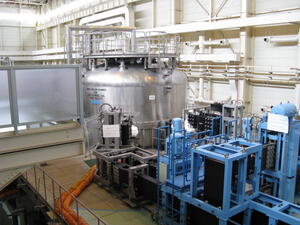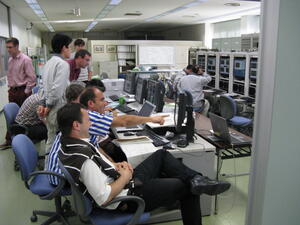Good news from Naka
In last week's edition of the ITER Newsline we reported on the successful tests of the PF Insert Coil conducted in Naka. Last Monday, 23 June, the conductor was successfully taken up to an operating point of 52kA at 6.5T and 4.6K. In this week's issue, Neil Mitchell, Head of ITER's Magnet Division, explains in more detail what exactly is happening in Naka these days.
The PF Insert Coil is currently being tested in Naka. What exactly is the PF Insert Coil and how is it made?
The PF Insert Coil is made from a 40m length of conductor for the ITER Poloidal Field Coils. The conductor is made of 1400 NbTi strands in what is called a cable-in-conduit configuration. The strands are about 0.75mm in diameter and are twisted together inside a steel tube. Helium flows in the gaps between the strands. The 40m of conductor is wound in a spiral and put inside the bore of the Central Solenoid Model Coil facility at Naka.
Can you describe what exactly is being tested, what is the goal of these tests?
The tests last about nine weeks. The first priority has been to measure the superconducting performance of the conductor. All superconductors have a limited range of operation (depending on field, current density and temperature) in which they remain superconducting. If these limits are exceeded, the conductor quenches. This means it becomes normal conducting and the current has to be decreased rapidly as the sudden increase in resistance means that the temperature increases rapidly so that the strands would melt in a few 10s of seconds. The PF Insert Coil thus allows us to measure the limit of the operation range under the same conditions as will be experienced in ITER's six PF coils (in particular the high field PF6).
These tests are performed in a special test facility in Naka. What makes it special?
The Central Solenoid Model Coil, set up in the testing station at JAERI in Naka, Japan, is a large Nb3Sn coil we built about eight years ago in the ITER EDA to test conductors up to 13T. For the PF insert we will test up to about 10T. It is the biggest Nb3Sn coil in the world (it uses about 27t of Nb3Sn material and the coils themselves weigh 110t) and the stored energy is about 700MJ, approximately comparable with the TF system of Tore Supra. It has a large bore into which insert coils can be fitted.
Talking about the latest promising results. What has been achieved and how do we interpret the recent results in regard to ITER operation.
The PFI conductor has performed at the level expected on the basis of the performance of the strands making up the cable. There is no degradation and no unexpected stability limits that have been known to reduce performance in NbTi coils (using different conductor designs). We actually designed the coil with a 1.5K temperature margin to the limiting performance (so that for example at 6.4K the coil operates with a current of 52kA and a temperature of 4.5K, but the limiting temperature at which quench occurs is 6.0K. We had expected that about 0.5K of this may be lost due to degradation and/or stability but actually it has not been, so we have possibly a little larger operation window than we expected. This is important for the operational window of the plasma as the PF6 coil capacity is one of the determining factors.




